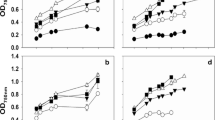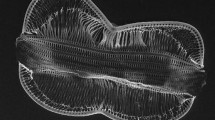Abstract
Biomass and neutral lipid accumulation were examined in Chaetoceros muelleri var. subsalsum and Navicula saprophila using a multivariate, fractional factorial design. Variables included were conductivity, temperature, nitrogen concentration, silicon concentration, time (culture age), and alkalinity. Measured characteristics included nile red fluorescence (as a measure of neutral lipid content) and ash-free dry weight (AFDW). Nitrogen concentration was the variable with the greatest effect on neutral lipid and ash-free dry weight accumulation over the ranges tested. Increasing conductivity in the range examined had a significant, negative impact on neutral lipid accumulation in both of these strains, while increasing alkalinity had a positive effect on lipid and ash-free dry weight in both strains. Experimental designs such as those described here have great potential utility in biological systems with complex interactions.
Similar content being viewed by others
References
American Public Health Association (1975) Alkalinity. In: Rand MC, Greenberg AE, Taras MJ (eds), Standard Methods for the Examination of Water and Wastewater, 14th Edn. American Public Health Association, Washington, D.C., 278–282.
Barclay W, Johansen J, Chelf P, Nagle N, Roessler P, Lemke P (1986) Microalgae Culture Collection 1986–1987. SERI/SP-232-3079, Solar Energy Research Institute, Golden, Colorado, 149 pp.
Barclay W, Nagle N, Terry K, Ellingsen S, Sommerfeld M (1987) Characterization of inland saline ground water for aquatic biomass production: a statistically-based approach J. Water Res. 28: 988–995.
Ben-Amotz A, Tornabene TG, Thomas WH (1985) Chemical profile of selected species of microalgae with emphasis on lipids. J. Phycol. 21: 72–81.
Box GEP, Behnken DW (1960) Some new three level designs for the study of quantitative variables. Technometrics 2: 455–475.
Brown LM (1982) Photosynthetic and growth responses to salinity in a marine isolate of Nannochloris bacillaris (Chlorophyceae). J. Phycol. 18: 483–488.
Brown LM (1985) Stepwise adaptation to salinity in the green alga Nannochloris bacillaris Can. J. Bot. 6: 327–332.
Cooksey KE, Guckert JB, Williams SA, Callis PR (1987) Fluorometric determination of the neutral lipid content of microalgal cell using nile red. J. microbiol. Methods 6: 333–345.
Collyer DM, Fogg GE (1955) Studies on fat accumulation by algae. J. exp. Bot. 6: 256–275.
Fogg GE (1956) Photosynthesis and formation of fats in a diatom. Ann. Bot. 20: 265–285.
Ignatiades L, Smayda TJ (1970) Autecological studies on the marine diatom Rhizosolenia fragilissima Bergon. I. The influence of light, temperature, and salinity. J. Phycol. 6: 332–339.
Johansen J, Lemke P, Nagle N, Chelf P, Roessler P, Galloway R, Toon S (1987) Addendum to Microalgae Culture Collection 1986–1987. SERI/SP-232-3079a, Solar Energy Research Institute, Golden, Colorado, 23 pp.
Laing I (1985) Growth response of Chaetoceros calcitrans (Bacillariophyceae) in batch culture to a range of initial silica concentrations. Mar. Biol. 85: 37–41.
Maddux WJ, Jones RF (1964) Some interactions of temperature, light intensity, and nutrient concentration during the continuous culture of Nitzschia closterium and Tetraselmis sp. Limnol. Oceanogr. 9: 79–86.
McCombie AM (1960) Actions and interactions of temperature, light intensity, and nutrient concentration on the growth of the green alga, Chlamydomonas reinhardi Dangeard. J. Fish. Res. Bd. Can. 17: 871–894.
Neenan B, Feinberg D, Hill A, McIntosh R, Terry K (1986) Fuels from Microalgae: Technology Status, Potential, and Research Requirements. SERI/SP-231-2550, Solar Energy Research Institute, Golden, Colorado, 149 pp.
Piorreck M, Pohl P (1984) Formation of biomass, total protein, chlorophylls, lipids, and fatty acids in green and bluegreen algae during one growth phase. Phytochem. 23: 217–223.
Piorreck M, Baasch KH, Pohl P (1984) Biomass production, total protein, chlorophylls, lipids, and fatty acids of freshwater green and blue-green algae under different nitrogen regimes. Phytochem. 23: 207–216.
Richardson B, Orcutt DM, Schwertner HA, Martinez CL, Wickline HE (1969) Effects of nitrogen limitation on the growth and composition of unicellular algae in continuous culture. Appl. Microbiol. 18: 245–250.
Richmond A (1986) Cell response to environmental factors. In: Richmond A (ed.), Handbook of Microalgal Mass Culture. CRC Press, Inc, Boca Raton, Florida, 69–99.
Shifrin NS, Chisholm SW (1981) Phytoplankton lipids: interspecific differences and effects of nitrate, silicate, and lightdark cycles. J. Phycol. 17: 374–384.
Siver PA (1983) A new thermal gradient device for culturing algae. Br. phycol. J. 18: 159–164.
Smayda TJ (1969) Experimental observations on the influence of temperature, light, and salinity on cell division of the marine diatom, Detonula confervacea (Cleve) Gran J. Phycol. 5: 150–157.
Sorokin C, Krauss RW (1961) Effects of temperature and illuminance on Chlorella growth uncoupled from cell division. Plant Physiol. 37: 37–42.
Spoehr HA, Milner HW (1949) The chemical composition of Chlorella; effect of environmental conditions. J. biol. Chem. 24: 120–149.
Suen Y, Hubbard JS, Holzer G, Tornabene TG (1987) Total lipid production of the green alga Nannochloropsis sp. QII under different nitrogen regimes. J. Phycol. 23: 289–296.
Taguchi S, Hirata JA, Laws EA (1987) Silicate deficiency and lipid synthesis of marine diatoms. J. Phycol. 23: 260–267.
Werner D (1966) Die Kieselsäure im Stoflwechsel von Cyclotella cryptica Reimann, Lewin, and Guillard. Arch. Mikrobiol. 55: 278–308.
Author information
Authors and Affiliations
Rights and permissions
About this article
Cite this article
Chelf, P. Environmental control of lipid and biomass production in two diatom species. J Appl Phycol 2, 121–129 (1990). https://doi.org/10.1007/BF00023373
Received:
Revised:
Accepted:
Issue Date:
DOI: https://doi.org/10.1007/BF00023373




